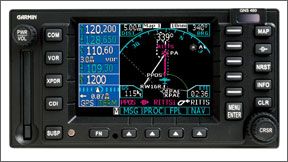The all-in-one GPS color mapcomm has become such an avionics standard that a used airplane without at least a Garmin GNS 430 hardly gets a second look. And for any owners planning an upgrade in this market, you’ll likely be sending money to Garmin anyway, for it owns all three mapcomm megaboxes, the GNS 430/530 and the GNS 480, which it acquired when it bought UPSAT in 2003. So which is best for a given airplane? There’s no easy answer, but in this article, we’ll summarize the major features of each. Each product does so much that we cant detail all of the operations. For this review, we’ll hit the high notes only.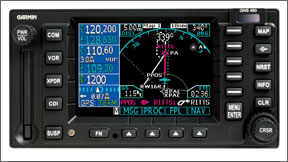
Garmin GNS480
When Garmin bought UPSAT, the CNX80-now the GNS 480-was a bit of candy thrown into the deal, since it had what the existing Garmin line lacked: WAAS-enabled GPS precision approaches. The GNS 480 has endured some controversy recently, with rumors of it becoming orphaned. Despite this, the GNS 480 remains in production even if overshadowed by the flagship GNS 530W and the lower-end GNS 430W.
We have mixed sentiments regarding the future of the GNS 480 because of its perceived popularity and the vibes we get from the factory. Its a great box, but not a great seller. Still, it has some useful tricks still unmatched by the GNS 430/530 and it retains strong appeal to a certain breed of IFR pilot.
The GNS 480 is the ideal size for replacing an old Bendix/King KX170B or Narco MK12D, although in a world of big-screen MFDs, weve heard complaints that the screen characters are a reach for aging eyes. In our view, on-screen nomenclature, although small, is crisp and bright. It does we’ll in sun-splashed cockpits and at wide viewing angles in larger cockpits.
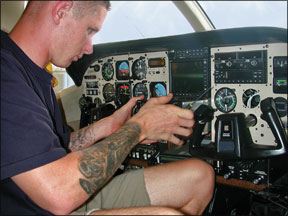
Its map display-there are several pages of map formats to choose from-is down to business and is aviation intensive, rather than topographically detailed. Were particularly fond of the HSI-like navigation page that features a compass rose, and CDI and VDI for displaying electronic glideslope. On the downside, the GNS 480 has no terrain and obstacle features and it wont serve we’ll if you fly low and slow following roads and ground-based landmarks.
The standard comm has 8 watts and allows for monitoring the standby frequency at a lower volume-handy for catching ATIS without switching frequency. The digital navigation radio has a dual-station tracking VOR receiver and glideslope outputs for a variety of HSIs and the Garmin MD200 nav head. The GNS480 operates on 11- to 36-volt input power without need for converters.
The GNS 480 GPS engine has 15 channels (12 GPS and three GPS/WAAS) receiving signals through the Garmin A33 antenna, which is mounted on top of the cabin utilizing low loss cable. We recommend an avionics cooling fan as the unit can get toasty to the touch in tight panels.
Ergos and Mechanicals
Although we think the GNS 480 has good ergonomics, its chassis isn’t as rugged as the GNS 530 and 430. Installation connectors and the backplate arent as hardy as we would like, either, and this box has suffered intermittent connection problems due to the backplate flexing when loaded with meaty wiring harness.
While the other two Garmin boxes share identical operating logic, the GNS 480 is driven with “smart keys” whose function changes with context-pressing a smart key highlights the function to be edited, just as with a true FMS. One smart feature we especially like is that volume level indicator, which paints a small audio level graphic while you spin the knob.
Much of the GNS 480 operating architecture was designed by an airline pilot and it shows. The 480 is a hardcore IFR box, with all the approaches-including the WAAS procedures-and Victor airways, the only such navigator with this feature. If your flying includes regular IFR with flight plans with procedures inserted along the way and you have the brain power to handle a real FMS, this may be box for you.
On the other hand, if you struggle with the direct-to function on your current GPS or loran and youre a VFR-type guy, forget it. Weve witnessed pilots stare blankly into GNS 480s while the aircraft wandered off course in frustrating non-response to random button pushing. One caveat: If youve mastered the GNS 430/530 buttonology, don’t expect to operate a GNS 480 the same way. Theyre entirely different.
Integration
Here, the GNS 480 is weak, in our opinion. The GNS 480 outputs airway intercepts, procedure turns and holding patterns, but its not happy driving an old analog autopilot. Furthermore, it doesnt do datalink weather, radar or terrain and the only traffic option is TIS, which is in decline.
On the other hand, the GNS 480 excels at remote box interfaces. The transponder tuning and display menu lives in a data field on the left hand side of the screen executed with a XPDR button on the bezel, saving space and eliminating the transponder from the panel.
L-3s WX500 Stormscope can be overlaid and controlled remotely. you’ll also want a good audio system, since the GNS 480 includes voice callouts of “localizer alive” and other useful warnings.
As originally conceived by UPSAT, the GNS 480 was intended to work with the MX20 and now GMX200 MFD under Garmins tent. For example, when you load an approach in the GNS 480, it automatically calls and loads the appropriate Jeppesen Chart View approach plate on the GMX200. But with the GNS 530/GMX200 combination, you have to recall the chart recall manually.
Approvals wise, the GNS 480 is TSOd to C169A and has a long list of AML-STC models-no problem. But thats not to say the installation documentation is lenient. As with all the WAAS boxes, distances between the unit and its nav indicator must be followed for compliance with remote mode annunciation. While all the required GPS and nav mode annunciation lives on the GNS 480 screen, the feds want to be sure pilots remain in the situational loop. With everything done right, a GNS 480 installation might total $15,000-a good price, considering the capability this navigator brings to IFR flying.
Garmin GNS 530W
With Bendix/King all but out of the picture, Garmin had no trouble dominating the mapcomm market with the GNS 530, beginning in 2001. In the world of avionics, its still seen as the flagship of the panel, even though it doesnt touch the features found in the GNS 480. Its the priciest of the all products listed here, at $16,500 for a typical installed cost. Garmin now sells only the GNS 530W WAAS model. There’s a lot of screen area on the GNS 530W -4 inches wide by 3 inches high-but it also hogs panel room. With eight colors and 320 by 234 pixels, the GNS530Ws TFT LCD is adequate, but not exceptional compared to other displays.
The 5 Hz processor is new in the GNS530W, replacing the legacy products 1 Hz version. There’s a topographically detailed base map, a terrain map with obstructions fed by a user-replaceable datacard and a Jeppesen database that includes all published approaches, including GPS LPV approaches as we’ll as departure and arrival procedures.
A disappointment to us is the absence of airways in the database. There was hope that when Garmin upgraded the 530 to the 530W, airways would be added. But it didnt happen. The 12-channel plus differential GPS engine in the GNS 530W utilizes the GA35 GPS antenna and is a flawless performer, although signal lock-on seems to take longer with the W version than were accustomed to. The old Garmin GA56 antenna wont work with the GNS 530W GPS engine, so if youre upgrading, plan on a new antenna.
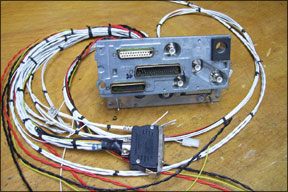
Standard is a 10-watt communications transceiver, but a 16-watt version is available for jets. A built-in VOR/LOC/glideslope receiver feeds any HSI that has an OBS resolver or the Garmin G110A built by Mid Continent Instruments.
Controls/Ergos
We think the GNS 530W sets the standard for the ultimate in rugged controls and ergonomic layout in panel-mounted avionics. Even the installation hardware, including mounting rack and solid-cast connector backplate, are built aircraft-tough. Forged into the backplate is an input port for forced cooling air injection. A cooling fan lives mid-chassis, but thats for cooling the display. Forced air cooling is imperative.
The left side of the GNS 530W houses nearly all the controls for comm and nav, as we’ll as on-screen nomenclature for each. All GPS and nav annunciation is shown in the lower left corner of the display, but remote mode annunciation will be required if the unit and nav head are a specified distance away from each other. See the sidebar for more on this regulatory requirement.
Unlike the GNS 480, the GNS 530W doesnt have audible warning outputs, thus its more compatible with older audio panels, although were still advocates of audio upgrades during the install. Weve always found the GNS 530/430 navigators to be intuitive to operate, or at least as intuitive as these boxes can be.
Menu-prompted interaction is comforting to many pilots, yet there are some who just don’t get it even after hours of training. Most intuitive to us is the loading and executing of approaches and procedures through the PROC key. In our estimation, this operating mentality beats the GNS480 hands down.
Remotes
Given the potential for remote interfaces, we think that the GNS 530W is a true multi-function display compared to the GNS 480, which is essentially a full-featured navigator. The GNS 530W can display just about any remote traffic box out there, including the GTX330 TIS transponder, Skywatch and Avidyne TAS active traffic
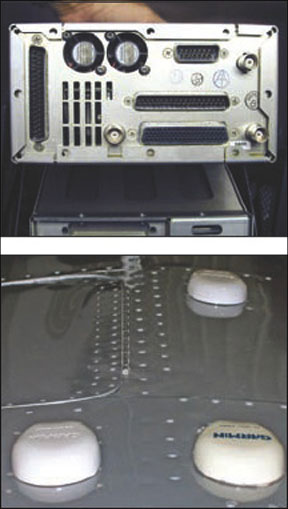
184
and older Ryan traffic boxes. A WX500 Stormscope can project lightning data, although as we go to press, Garmin is struggling with a software bug that erroneously flags a fictitious Stormscope heading message. Garmin says the problem will be fixed in a future software update.
XM Radio-based weatherlink and on-screen XM Radio audio tuning represents a major interface in the GNS 530 thats lacking in the GNS480. The data comes in via the RS232-linked Garmin GDL69 receiver. While the GNS 530W wont display all of the WxWorx/XM products, it will play the most important ones, including NEXRAD, textual and graphical METARs, TAFs and lightning data. Better weather graphics can be had on a portable GPSmap 396 or 496, either of which can be connected to a GNS 530W/GNS480 or GNS430W for data download. Many owners are asking for this interface, as a belt-and-suspender backup.
A TAWS-B-compliant version of the GNS 530W is offered and the standard GNS 530W has basic terrain and obstacle alerting on a dedicated terrain page. Many users simply arent impressed with this terrain alerting, but it works as advertised, even if you shouldnt count on it solely to keep out of the rocks. Through its high-speed ARINC output, the GNS 530W feeds roll steering commands to compatible autopilots which can fly procedure turns and holding patterns. The GNS 530W has plenty of ARINC and RS232 outputs (and inputs) for future growth potential and it interfaces nicely with modern autopilots.
Installation
With the new GNS 530W comes an AML-STC for installation approval, a welcome bonus for new installs. Unless the aircraft isn’t listed on the AML or the installation deviates from the documentation, field approvals shouldnt be required. Many aircraft will require remote GPS mode annunciation if the GNS 530W is mounted out of the prescribed viewing scan, easily adding $1000 to the installation invoice.
Our annunciator of choice is Mid Continents MD41 ACU, which is small and has a high-quality sunlight-readable display.
The biggest obstacle in installation is making room for the size of the GNS 530W with the rest of the equipment needed in the stack. Installed price could top $17,000. If that price stops you cold or your panel is tight, read on.
Garmin GNS 430W
Think of a $10,750 GNS 430W as a slightly scaled back and smaller GNS 530W. The GNS 430W screen has eight colors, but is dwarfed when stacked underneath a GNS 530W. Size wise, the 430 screen is more like the GNS 480, but isn’t nearly as crisp.
But the GNS 430W has virtually the identical features as a larger GNS 530W, including WAAS, the same 10-watt comm and full navigation capabilities. A 16-watt comm is also available for the GNS 430W.
The GNS 430W has one less map page than the GNS 530W, a default nav page thats an ARINC-style look-ahead view with on-screen CDI that we find useful when flying an approach. With the GNS 430W, you’ll need to settle for the basic moving map page.
You can connect the same remote systems to the GNS 430W that you can to the GNS 530W. The only rub is that you’ll eat up the screen space in short order. Our opinion is that weather displayed on a GNS 430W is good for avoidance rather than tactical penetration, something thats even marginal with a GNS 530W.
The real weather picture is best viewed on a high-res, color-rich MFD such as the GMX200 or Avidyne EX500. The GNS 430W may be perfect to pair to a GMX200 or EX500, since it offers everything you need for IFR and VFR flight, with the exception of airways, which can be viewed on a GMX200 anyway. you’ll need to budget around $12,000 for a GNS 430W install, which represents a price increase due to its WAAS status.
Conclusion
Which of the three navigators you choose will likely be governed by your budget and your typical mission. If youre a day-tripper and occasional IFR pilot punching your way through a cloud layer, we cant see investing the brain-power necessary to master an IFR-intensive GNS 480. If you follow an airline-pilot mentality in your flying, are computer savvy and always fly diverse routes under IFR, you might consider the GNS 480. Understand, however, that its remote interface potential is limited and you’ll likely need to buy a real MFD to play weather, traffic, terrain and future features.
If youre like the majority of the owner population, you fly both VFR and IFR, have aging eyes and worries about future growth potential, we believe the GNS 530W is a wise investment. The WAAS capability and newly updated processor makes it modern again.
But for basic aircraft that are panel-space deprived and for owners on a limited budget, the GNS 430W is a reasonable alternative, especially if traffic and Stormscope interface are your only demands. You can always play datalink weather on a GPSmap 496.
Larry Anglisano is
Aviation Consumers avionics editor.
